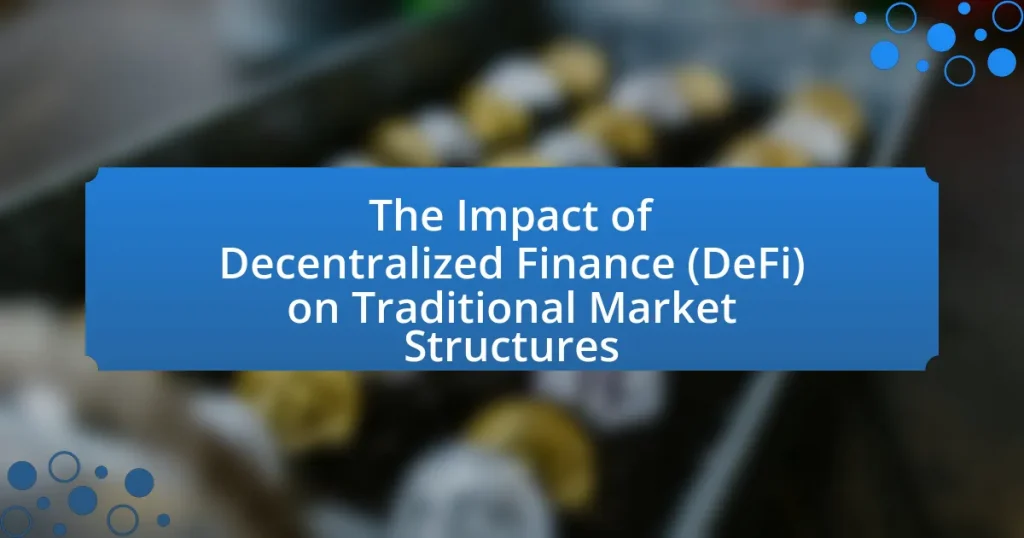Decentralized Finance (DeFi) is a transformative force reshaping traditional market structures by removing intermediaries, enhancing accessibility, and increasing efficiency through blockchain technology. This article examines how DeFi differs from traditional finance, highlighting its key characteristics such as decentralization, transparency, and programmability, which challenge established financial systems. It also explores the potential benefits of DeFi, including improved financial inclusion and reduced transaction costs, while addressing the risks and challenges it poses, such as regulatory uncertainty and security concerns. Additionally, the article discusses the implications of DeFi on sectors like banking and investment management, and outlines trends and best practices for stakeholders engaging with this evolving financial landscape.
-on-Traditional-Market-Structures-1.webp)
What is the Impact of Decentralized Finance (DeFi) on Traditional Market Structures?
Decentralized Finance (DeFi) significantly disrupts traditional market structures by eliminating intermediaries, enhancing accessibility, and increasing market efficiency. Traditional finance relies on centralized institutions like banks and brokers, which impose fees and restrictions; DeFi platforms, on the other hand, utilize blockchain technology to facilitate peer-to-peer transactions without intermediaries, reducing costs and barriers to entry. For instance, DeFi protocols like Uniswap and Aave allow users to trade and lend assets directly, resulting in lower transaction fees and faster execution times compared to traditional exchanges. Furthermore, DeFi’s open-source nature fosters innovation and competition, challenging the monopolistic tendencies of established financial institutions. According to a report by the World Economic Forum, the DeFi market grew from $1 billion in total value locked in 2020 to over $80 billion by 2021, illustrating its rapid adoption and impact on traditional finance.
How does DeFi differ from traditional finance?
DeFi, or Decentralized Finance, differs from traditional finance primarily in its reliance on blockchain technology and smart contracts, which eliminate the need for intermediaries like banks. In traditional finance, transactions require trusted third parties to facilitate and verify, leading to higher costs and slower processes. In contrast, DeFi operates on a peer-to-peer basis, allowing users to engage directly with financial services, resulting in lower fees and faster transactions. Additionally, DeFi platforms are typically open-source and accessible to anyone with an internet connection, promoting greater financial inclusion compared to the often restrictive nature of traditional financial systems.
What are the key characteristics of DeFi?
The key characteristics of DeFi include decentralization, transparency, accessibility, programmability, and composability. Decentralization allows users to interact directly without intermediaries, reducing reliance on traditional financial institutions. Transparency is achieved through blockchain technology, enabling all transactions to be publicly verifiable. Accessibility ensures that anyone with an internet connection can participate, breaking down barriers to entry. Programmability refers to the use of smart contracts, which automate processes and reduce the need for manual intervention. Composability allows different DeFi applications to interact seamlessly, creating a more integrated financial ecosystem. These characteristics collectively enhance efficiency and innovation in financial services.
How do these characteristics challenge traditional financial systems?
Decentralized Finance (DeFi) characteristics challenge traditional financial systems by eliminating intermediaries and enabling peer-to-peer transactions. This shift reduces reliance on banks and financial institutions, which traditionally control access to financial services. For instance, DeFi platforms utilize smart contracts on blockchain technology to automate processes, increasing efficiency and transparency while lowering costs. According to a report by the World Economic Forum, DeFi could potentially disrupt the $300 trillion global financial services industry by providing more inclusive access to financial products. This democratization of finance undermines the established power dynamics and regulatory frameworks of traditional systems, forcing them to adapt or risk obsolescence.
What are the potential benefits of DeFi for market structures?
Decentralized Finance (DeFi) offers several potential benefits for market structures, including increased accessibility, enhanced liquidity, and reduced costs. By eliminating intermediaries, DeFi platforms allow users to engage in financial transactions directly, which broadens access to financial services for individuals who may be underserved by traditional banking systems. Furthermore, DeFi protocols often facilitate greater liquidity by enabling users to trade assets 24/7 without the constraints of traditional market hours, leading to more efficient price discovery. Additionally, the use of smart contracts in DeFi reduces transaction costs and processing times, as they automate processes that would typically require manual intervention. These benefits collectively contribute to a more inclusive and efficient financial ecosystem.
How can DeFi enhance financial inclusion?
DeFi can enhance financial inclusion by providing access to financial services for unbanked and underbanked populations. Traditional banking systems often exclude individuals due to high fees, lack of identification, or geographical barriers. DeFi platforms, operating on blockchain technology, enable users to engage in lending, borrowing, and trading without intermediaries, thus lowering costs and removing entry barriers. According to a report by the World Bank, approximately 1.7 billion adults worldwide remain unbanked, highlighting the potential for DeFi to serve these individuals by offering decentralized applications that require only internet access and a digital wallet. This accessibility can empower users to participate in the global economy, fostering economic growth and stability.
What efficiencies does DeFi introduce to market transactions?
Decentralized Finance (DeFi) introduces significant efficiencies to market transactions by eliminating intermediaries, thereby reducing costs and increasing transaction speed. Traditional financial systems often involve banks and brokers, which add layers of fees and delays; DeFi platforms operate on blockchain technology, allowing peer-to-peer transactions that are executed almost instantaneously and at a fraction of the cost. For instance, Ethereum-based DeFi protocols can facilitate transactions in seconds, compared to the hours or days required in traditional finance. Additionally, DeFi enhances accessibility, enabling anyone with an internet connection to participate in financial markets, which broadens market participation and liquidity.
What risks and challenges does DeFi pose to traditional market structures?
DeFi poses significant risks and challenges to traditional market structures primarily through increased volatility, regulatory uncertainty, and systemic risk. The decentralized nature of DeFi allows for rapid price fluctuations, which can destabilize traditional financial markets that rely on stability and predictability. Additionally, the lack of regulatory oversight in DeFi creates challenges for traditional institutions that must comply with stringent regulations, leading to potential legal and operational conflicts. Furthermore, the interconnectedness of DeFi protocols can introduce systemic risks, as failures in one protocol can cascade through the entire ecosystem, affecting traditional financial systems. For instance, the collapse of the TerraUSD stablecoin in May 2022 highlighted how vulnerabilities in DeFi can impact broader market confidence and stability.
How does regulatory uncertainty affect DeFi’s impact?
Regulatory uncertainty significantly diminishes DeFi’s impact by creating an environment of risk that discourages investment and innovation. When regulations are unclear or inconsistent, potential users and developers may hesitate to engage with DeFi platforms due to fears of legal repercussions or sudden regulatory changes. For instance, the lack of clear guidelines from authorities like the U.S. Securities and Exchange Commission has led to a cautious approach among institutional investors, which in turn stifles the growth and adoption of DeFi solutions. This hesitance can result in reduced liquidity and market participation, ultimately limiting DeFi’s ability to disrupt traditional financial systems effectively.
What security concerns are associated with DeFi platforms?
DeFi platforms face significant security concerns, primarily including smart contract vulnerabilities, hacking incidents, and lack of regulatory oversight. Smart contracts, which automate transactions, can contain coding errors or exploits that hackers can manipulate, leading to substantial financial losses; for instance, the DAO hack in 2016 resulted in a loss of $60 million due to a vulnerability in its smart contract. Additionally, DeFi platforms are frequent targets for hacking, with reports indicating that over $1.3 billion was stolen from DeFi protocols in 2021 alone. Furthermore, the absence of regulatory frameworks increases the risk of fraud and scams, as users often lack recourse in the event of a security breach. These factors collectively highlight the critical security challenges associated with DeFi platforms.
How is DeFi influencing investor behavior in traditional markets?
DeFi is influencing investor behavior in traditional markets by promoting greater accessibility and transparency in financial transactions. This shift encourages investors to seek decentralized alternatives to traditional financial services, leading to increased participation in digital asset markets. For instance, a report by the World Economic Forum indicates that DeFi platforms have attracted over $80 billion in total value locked, demonstrating a significant movement of capital away from conventional financial institutions. Additionally, the rise of yield farming and liquidity mining in DeFi has incentivized traditional investors to explore higher returns, altering their risk appetite and investment strategies.
What role does technology play in the evolution of DeFi?
Technology is fundamental to the evolution of Decentralized Finance (DeFi) as it enables the creation, execution, and management of financial services on blockchain networks. Smart contracts, which are self-executing contracts with the terms directly written into code, facilitate trustless transactions and automate processes without intermediaries, significantly reducing costs and increasing efficiency. The Ethereum blockchain, for instance, has been pivotal in this evolution, hosting numerous DeFi applications that allow users to lend, borrow, and trade assets in a decentralized manner. According to a report by DeFi Pulse, the total value locked in DeFi protocols surpassed $80 billion in 2021, illustrating the rapid growth and adoption driven by technological advancements.
What specific sectors are most affected by DeFi?
The specific sectors most affected by DeFi include banking, insurance, and asset management. In banking, DeFi disrupts traditional lending and borrowing by enabling peer-to-peer transactions without intermediaries, which can lower costs and increase accessibility. In insurance, DeFi introduces decentralized insurance protocols that allow users to pool funds and share risks, challenging conventional insurance models. In asset management, DeFi facilitates the creation of decentralized exchanges and automated investment strategies, which can outperform traditional fund management by reducing fees and increasing transparency. These sectors are experiencing significant transformation due to the innovative financial products and services offered by DeFi platforms.
How is the banking sector responding to the rise of DeFi?
The banking sector is increasingly adopting decentralized finance (DeFi) technologies to enhance their services and remain competitive. Major banks are exploring partnerships with DeFi platforms, investing in blockchain technology, and developing their own digital assets to streamline operations and reduce costs. For instance, JPMorgan has launched its own cryptocurrency, JPM Coin, to facilitate cross-border payments, demonstrating a proactive approach to integrating DeFi principles. Additionally, a report by the World Economic Forum indicates that over 10% of global GDP could be stored on blockchain by 2027, prompting banks to innovate and adapt to this emerging landscape.
What changes are occurring in investment management due to DeFi?
Investment management is undergoing significant changes due to DeFi, primarily through increased accessibility, reduced costs, and enhanced transparency. DeFi platforms enable investors to access financial services without intermediaries, allowing for lower fees and faster transactions. For instance, according to a report by the World Economic Forum, DeFi could potentially reduce transaction costs by up to 90% compared to traditional finance. Additionally, the use of smart contracts in DeFi enhances transparency and security, as all transactions are recorded on a public blockchain, making it easier to audit and verify. These changes are reshaping how investment management operates, promoting a more democratized financial ecosystem.
What are the future implications of DeFi on traditional market structures?
Decentralized Finance (DeFi) is poised to significantly disrupt traditional market structures by enhancing accessibility, reducing costs, and increasing transparency. As DeFi platforms eliminate intermediaries, they enable direct peer-to-peer transactions, which can lower transaction fees and increase efficiency compared to traditional financial systems. For instance, a report by the World Economic Forum indicates that DeFi could potentially reduce the cost of financial services by up to 90% by streamlining processes and minimizing reliance on centralized institutions. Furthermore, the transparency inherent in blockchain technology allows for real-time auditing and tracking of transactions, which can enhance trust and accountability in financial markets. This shift may lead to a re-evaluation of regulatory frameworks as traditional institutions adapt to the growing influence of DeFi, potentially resulting in a more democratized financial landscape.
How might DeFi reshape the landscape of financial services?
DeFi, or Decentralized Finance, is poised to fundamentally reshape the landscape of financial services by eliminating intermediaries and enabling peer-to-peer transactions. This shift allows for greater accessibility, as individuals can engage in financial activities without the need for traditional banks or financial institutions, which often impose high fees and stringent requirements. For instance, DeFi platforms like Uniswap and Aave facilitate trading and lending directly between users, significantly reducing costs and increasing efficiency. Furthermore, the transparency and security provided by blockchain technology enhance trust in financial transactions, as all activities are recorded on a public ledger. According to a report by the World Economic Forum, by 2025, 10% of global GDP could be stored on blockchain technology, highlighting the potential scale of DeFi’s impact on traditional financial systems.
What trends should investors watch regarding DeFi’s growth?
Investors should watch the increasing integration of DeFi with traditional finance as a key trend in DeFi’s growth. This integration is evidenced by the rise of decentralized exchanges (DEXs) and lending platforms that are attracting institutional interest, with platforms like Aave and Uniswap seeing significant trading volumes. Additionally, regulatory developments are shaping the landscape, as governments are beginning to establish frameworks for DeFi, which could enhance legitimacy and attract more investors. For instance, the total value locked (TVL) in DeFi reached over $100 billion in 2021, indicating substantial market interest and growth potential.
What best practices should stakeholders consider when engaging with DeFi?
Stakeholders engaging with DeFi should prioritize thorough research and risk assessment. Understanding the underlying protocols, smart contracts, and the specific DeFi projects is crucial, as evidenced by the high incidence of vulnerabilities in smart contracts, with reports indicating that over $1.3 billion was lost to hacks and exploits in 2021 alone. Additionally, stakeholders should ensure compliance with regulatory frameworks, as the evolving legal landscape can impact the viability of DeFi projects. Engaging with reputable platforms and utilizing security audits can mitigate risks, as highlighted by the fact that projects with third-party audits have significantly lower instances of security breaches. Lastly, diversifying investments within DeFi can help manage risk exposure, given the volatility often associated with cryptocurrencies and DeFi assets.


